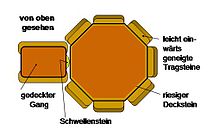Polygonal poles

The polygonal dolmen is a form of Nordic dolmen architecture . It occurs particularly often in the north of the Danish island of Zealand , in the Swedish province of Bohuslän and on the Cimbrian Peninsula (e.g. Troldkirken in Jutland ). In Schleswig-Holstein there are 11 preserved examples of polygonal dolms; in Lower Saxony , Mecklenburg-Western Pomerania ( polygonal towers from Lexow ) and Saxony-Anhalt ( large stone graves near Lüdelsen ) only a few specimens have survived. Neolithic monuments are an expression of the culture and ideology of Neolithic societies. Their origin and function are considered to be the hallmarks of social development.
Five to nine bearing stones form the polygonal chamber floor plan, which is mostly penta- or hexagonal. A single, often particularly large, capstone lies on top. A pre-built corridor is mandatory, but often not preserved. In Dithmarschen , the rectangular and polygonal poles of Albersdorf form a focus. The Brutkamp is one of the most impressive facilities of this type. From a typological perspective, one of the 13 chambers of Hemmelmark, Rendsburg-Eckernförde district , protrudes with the unusual size of 2.8 × 2.25 m and the division of a quarter by upright slabs. Polygonal dolms are less common in hunebeds (Schülldorf, Rendsburg-Eckernförde district) and more frequently in round hills. (e.g. Dannewerk , Eckernförde , Haßmoor and Süderende ).
Originally, Ekkehard Aner (born 1914) and Johannes Brøndsted (1890–1965) assumed a western origin of this type due to the approximately round building. These views have been refuted since the comprehensive study by Ewald Schuldt in Mecklenburg-Western Pomerania , which highlighted the autochthonous emergence of the different types.
See also
literature
- Friedrich Laux : A polygonal pier in northern Lower Saxony In: Die Kunde NF 21 1970 pp. 61–68
- Jutta Roß: Megalithic graves in Schleswig-Holstein. Investigations into the structure of the tombs based on recent excavation findings . Kovač, Hamburg 1992, ISBN 3-86064-046-1 (also: Hamburg, Univ., Master's thesis, 1987).
- Ewald Schuldt : The Mecklenburg megalithic graves. Research on their architecture and function . Deutscher Verlag der Wissenschaften, Berlin 1972 ( contributions to the prehistory and early history of the districts of Rostock, Schwerin and Neubrandenburg . 6, ISSN 0138-4279 ).
- Jürgen E. Walkowitz: The megalithic syndrome. European cult sites of the Stone Age (= contributions to the prehistory and early history of Central Europe. Vol. 36). Beier & Beran, Langenweißbach 2003, ISBN 3-930036-70-3 .
Individual evidence
- ↑ This fine division of dolmens into subtypes is only common in Germany. These types do not occur in the Netherlands or Poland. In Denmark and Sweden a distinction is only made between dolmen (Dysse, Döse) and passage grave. But here with dolmens the shape of the hill (round or long) is included in the nomenclature.
- ↑ J. Müller In: Varia neolithica VI 2009 p. 15

